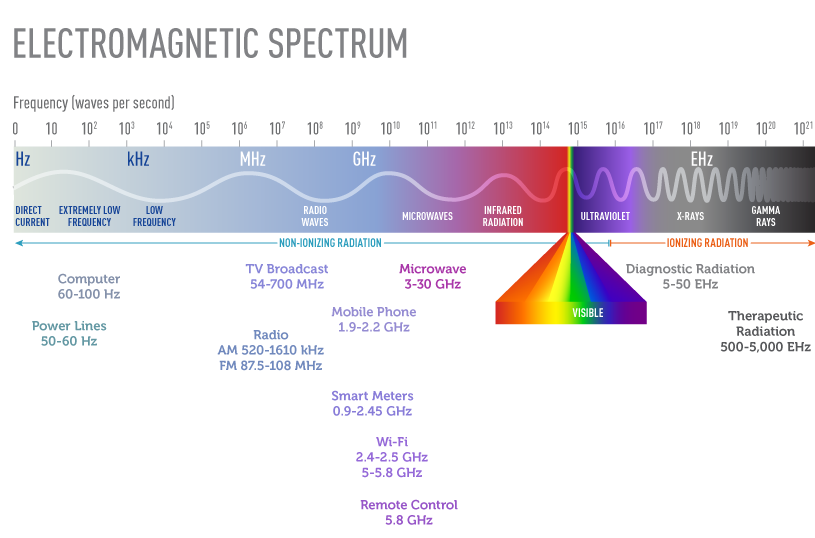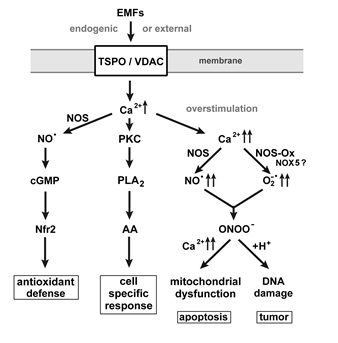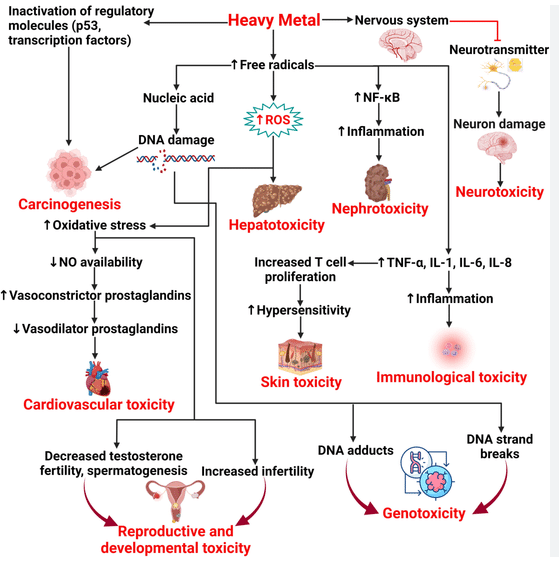EMFs and Heavy Metal Burdens

Environmental toxicities such as EMFs and heavy metals have become one of the greatest global health burdens. It’s not only developing countries or a socio-economic issue, Australians are also at risk. A 2017 systematic review of 133 diseases and injuries showed that 23% of global deaths and 22% of global Disabilities Adjusted Life Years (DALYs) can be attributed to environmental risks in the year 2012 and that this burden is dominated by non-communicable diseases. In the last 10 years, the growth has been significant (1).
According to the World Health Organization (2017), non-communicable diseases kill 40 million people each year, equivalent to 70% of all deaths globally. These findings are further confirmed by evidence that intrinsic risk factors contribute less than 30% of cases to the development of cancer (2), and that there is a progressive rise in the incidence of childhood cancer (3), chronic diseases including neurodevelopmental disorders, psychiatric and neurodegenerative diseases ie. Dementia, Parkinson and Alzheimer’s disease and metabolic disorders such as obesity, diabetes type 1 and 2.
Assessing and reducing environmental exposures to heavy metals, chemicals and EMFs could potentially be the greatest contribution to a global reduction in disease!
Heavy Metals
Heavy metals are naturally occurring elements with atomic weight and density at least 5 times that of water. Their use in industry, agriculture, medical applications, technology, homes and even in food, has led to them being ubiquitous in the environment; causing concerns for human health. Toxicity depends on several factors including the dose, route of exposure, and chemical species, as well as the age, gender, genetics, and nutritional status of exposed individuals.
Because of their high degree of toxicity, arsenic, cadmium, lead, and mercury rank among the priority minerals that are of public health significance. They are known as systemic toxicants as they induce multiple organ damage, even at lower levels of exposure. They are also classified as human carcinogens (known or probable) according to the U.S. Environmental Protection Agency, and the International Agency for Research on Cancer. Other minerals of concern include Beryllium, Uranium, Aluminium, Antimony, Nickel, Thallium, Tin etc. Much research has been performed over the last fifty years in an attempt to understand the molecular mechanisms of toxicity, genotoxicity, and carcinogenicity.
EMF – The basics
Electric and magnetic fields are radiation produced by electricity. A magnetic field results from the flow of current through wires or electronic devices and increases as the current increases. A magnetic field quickly decreases with distance but can pass through buildings, most materials and even humans. Electric fields are produced by voltage and are always emitted from electronic devices even when the device is off. Together these fields are referred to as Electromagnetic Fields or EMF’s.
Higher-Frequency EMFs produce ionizing radiation and include x-ray, gamma rays etc and there is complete agreement that these cause DNA and cellular damage. Mid, Low and Extremely low (ELF-EMF) emit non-ionizing EMF’s and include electric power lines and devices, computers, tablets, mobile phones, smart meters, Wi-Fi, microwaves etc (4). Non-ionising radiation means that it has insufficient energy to break chemical bonds or remove electrons (ionisation). It makes ELF-EMF sound safe, doesn’t it?

Image: Spectrum showing possible frequencies of the electromagnetic spectrum. (4)
Thermal effects are associated with the heat created by EMFs – interaction with living tissue causes an energy transfer resulting in a rise in temperature. On the other hand, Non-thermal effects are effects that are not due to the increase of thermal energy of the material, instead the energy itself directly couples to energy modes within the molecule or lattice.
With the rapid growth in the last decades of wireless digital technology, an ever-increasing number of people are claiming that it is affecting their health. It would appear research is highly biased and EMF safety standards are based on thermal effects rather than biological effects.
In 2017 the International Journal of Oncology published a paper – World Health Organization, radiofrequency radiation and health – a hard nut to crack (Review). It looks at the industry involvement in assessing EMF safety and controlling the dialogue at WHO. (5)
This seems reminiscent of the scientists view on smoking, for decades the conclusion reached was no clear determination of harm.
In 2021 a major Australian study led by Ken Karipidis (6) concluded that there is “no confirmed evidence that low-level RF fields above 6 GHz such as those used by the 5 G network are hazardous to human health”.
In November 2022 a “Comment” was published in the same journal by an Australian team led by Steven Weller et al (7). They evaluated the Katipidis study and found misstatements, misclassifications, and exclusions of important findings from other research (ignoring well over 70 research papers) as well as funding bias! It concluded that risks to humans and the environment identified in past epidemiological studies, as well as unknown risks yet to be identified, warrant the application of a precautionary approach.
EMF – Mechanisms
Dr Martin Pall Professor Emeritus (Washington State University) has published a considerable number of papers showing there is high sensitivity to EMFs by the voltage sensors in each of our cells, which has a massive impact on our bodies.
This can include opening the blood-brain barrier, oxidative stress, single and double DNA strand breaks, and more. In 2022 he documented the relationship between EMFs and neurodegeneration due to calcium channel effects and excessive calcium ions in cells.
Dr Magda Havas, PhD, describes the symptoms of electrohypersensitivity (the portion of the population that experience an adverse reaction to exposure) as similar to the symptoms experienced by radar operators in the 1940s to the 1960s’. The response includes clumping (rouleau formation) of the red blood cells, heart palpitations, pain or pressure in the chest accompanied by anxiety, and an upregulation of the sympathetic nervous system coincident with a downregulation of the parasympathetic nervous system typical of the “fight-or-flight” response
In 2019, New Hampshire Commissioned a study to assess the Environmental & Health Effects of Evolving 5G Technology (8). Dr Paul Heroux, Professor of Toxicology and Heath Effects of Electromagnetism at McGill University reviewed 1,724 peer-reviewed studies to show that the radio-frequency bioeffects include Neuro-behavioural effects, DNA damage, altered gene expression, Brain activity changes and cells apoptosis.
EMF – Mechanisms & Effects

A German study in 2021 on cells exposed to EMF with a focus on Voltage-dependent Calcium channels (VDCC) viewed differing effects of EMFs based on the exposure level (9). Short exposure periods, the induced Ca2+ influx leads to NO• radical production, prolonged exposure led to oxidative-stress conditions, whereas high and continuing EMF applications were able to provoke effects such as DNA damage, lipid peroxidation, mitochondrial dysfunction and apoptosis – as shown in the image (9).
Further studies looking at “electro-hypersensitivity”, appear to involve oxidative stress, inflammation and hyper-histaminemia, autoimmune response, deficits in melatonin metabolic activity, and other changes that may present an increased risk for chronic neurodegenerative diseases (10). There is also a considerable amount of research suggesting links between EMF radiation and cancer, including breast cancer, immune dysfunction, reproductive disorders, ALS, and that prolonged smartphone use can increase the risk of tumours (11, 12).
Heavy Metal & EMFs
A heavy metal burden makes us more vulnerable to electromagnetic pollution and EMFs make us more vulnerable to heavy metals. There have been many studies in recent years looking at co-exposure.
Firstly, there are similarities in the mode of action or mechanism for both; but it’s also significant to consider response addition, ie where the same physiological response occurs as a result of exposure.

Mechanisms of Heavy Metal Exposure (13)
Many studies show exposure to both EMF & Heavy Metals results in increased free radical production, a biological mechanism for carcinogenesis, hepatoxicity, nephrotoxicity and Immunological toxicity. (14)
In other situations – heavy metals and EMFs work synergistically. A Lead burden, for example, in the presence of EMF, exacerbates the oxidative damage to plasma proteins as well as the conformational changes in haemoglobin as shown by a 2016 toxicology study (15). In the study, artificial neural networks were used as a predictive tool to assess the oxidative danger posed to workers in industrial fields, battery manufacturing companies, and power plants.
Other studies have looked at the co-exposure of metals such as Cadmium & static magnetic (SMF) fields which shows evidence that EMF in the vicinity of chemical and physical agents can aggravate their toxic properties (16). Amara reported the synergistic effects of static magnetic fields and cadmium on the activity of antioxidant enzymes, led to increased oxidative damage in rat brain tissue.
In certain scenarios, EMFs are inducing the prosthetics in our body to break down at a greater rate. A 2018 study that looked at the effects of EMFs emitted from mobile phones on the level of nickel release from orthodontic braces found a statistically significant increase with mobile phone exposure (21). Similarly, increased release of mercury from dental amalgam after exposure to electromagnetic fields such as those generated by MRI and mobile phones has been well reported (22, 23).
Reducing Exposure & Assessment
Although it is no longer possible to avoid exposure to both Heavy Metals and EMF, the first step is to reduce exposure.
To reduce heavy metal burdens – simple steps such as eating S.M.A.S.H. fish (sardines, mackerel, anchovies, salmon, and herring) which are known to have low levels of mercury and other toxins and are also high in omega-3 fatty acids; reducing vegetables from the Dirty Dozen and increasing those from the Clean Fifteen; limit rice – especially brown; filter drinking water (and if possible, all water in the home) and limit highly processed foods.
Avoid chemical products in the home eg. cleaners, personal products, pesticides etc, leave shoes at the door, leave home printers in ventilated areas, add air-filtering indoor plants to your home from the NASA list, remove computers and other electronic devices from bedrooms, put the Wi-Fi on an automated switch so it turns off at night, leave phones and other Wi-Fi out of the bedrooms (or at least place in a drawer away from the bed) are a great start.
Hair Tissue Mineral Analysis (HTMA) is an excellent method of assessing nutrient minerals essential for the body’s ability to naturally detoxify continually. Levels of Sulphur, Selenium, Calcium, Potassium, Zinc and Iron need to be optimal for efficiency. HTMA also clearly shows whether there is a heavy metal burden, and which heavy metals are an issue, it shows Adrenal and Thyroid function and gives helpful biomarkers indicative of Liver health.
Testing exposure utilising a urine challenge test has become less useful today as we are constantly exposed to heavy metals, and our body is constantly detoxifying them. The key is not what we are excreting, but rather what we are storing. One cm of hair is equivalent to 30 Litres of urine testing – as it assesses the load of minerals averaged over a month, rather than what is excreted in urine representing the last couple hours. Blood testing is key for acute toxic poisoning rather than an ongoing assessment of body burden.
Protection & Building Resilience
Antioxidants such as Vitamin C, Vitamin E family and Beta-carotene are important for their protective effects. Toxicology research, especially through animal studies, further confirms the use of the Vitamin E family as protection against EMFs (17). More recent studies showed Vitamin E together with Selenium gave further increased protection (18).
Vitamin C is an important water-soluble antioxidant that is able to neutralize ROS and reduce oxidative stress. It can also act as a chelator of metal ions and as a source of toxic free radicals in metals and metalloids catalysed reactions (19).
An optimal level of nutrients and trace minerals provides resilience and natural protection through effective detoxification pathways. It’s also important to note excessive accumulation of minerals can be as detrimental as a deficiency.
Conclusion
Significant evidence is available, which should be sufficient to invoke a precautionary approach to the continual production and growth of “electrosmog”, with the high percentage of humans, plants and animals being exposed. Further, it’s important to view EMFs and heavy metal health effects through the context of exposome, a concept coined by molecular epidemiologist Christopher Wild, in 2005. Exposome considers all the exposures of an individual through their lifetime and how those exposures relate to health. Exposures begin prior to birth and include insults from environmental and occupational sources, remembering it’s not just a single pollutant but the multiple and heterogeneous exposures of all the pollutants combined.
Although there are countless detox formulations, detox diets, etc being marketed – it is important to note that there are different physiologic mechanisms involved with different metals, and they have very different properties for example some are lipophilic, whilst others are osteophillic. Assessment with a Hair Tissue Mineral Analysis is essential to first understand which toxic minerals are of concern, which nutritional minerals are at excess levels, and where a deficiency may exist so that therapy can be targeted and tailored appropriately. Unlike EMF exposure, heavy metal exposure can be quantified – test don’t guess!
Ann Wine
Nutritionist, Senior Education
InterClinical Laboratories
References
- Pruss-Ustun, A., Wolf, J., Corvalan, C., Neville, T., Bos, R., Neira, M., 2017. Diseases due to unhealthy environments: an updated estimate of the global burden of disease attributable to environmental determinants of health. Journal of public health 39, 464-475.
- Wu, S., Powers, S., Zhu, W., & Hannun, Y. A. (2016). Substantial contribution of extrinsic risk factors to cancer development. Nature, 529(7584), 43–47. https://doi.org/10.1038/nature16166
- Eva Steliarova-Foucher, Murielle Colombet, Lynn A G Ries, Florencia Moreno, Anastasia Dolya, Freddie Bray, Peter Hesseling, Hee Young Shin, Charles A Stiller, et al International incidence of childhood cancer, 2001–10: a population-based registry study, The Lancet Oncology, Volume 18, Issue 6, 2017, Pages 719-731, ISSN 1470-2045, doi.org/10.1016/S1470-2045(17)30186-9.
- Electromagnetic Fields and Cancer National Cancer Institute https://www.cancer.gov/about-cancer/causes-prevention/risk/radiation/electromagnetic-fields-fact-sheet
- Hardell, Lennart. (2017). World Health Organization, radiofrequency radiation and health – a hard nut to crack (Review). International Journal of Oncology. 51. 10.3892/ijo.2017.4046.
- Karipidis, K., Mate, R., Urban, D. et al.5G mobile networks and health—a state-of-the-science review of the research into low-level RF fields above 6 GHz. J Expo Sci Environ Epidemiol 31, 585–605 (2021). https://doi.org/10.1038/s41370-021-00297-6
- Weller, S., May, M., McCredden, J. et al.Comment on “5G mobile networks and health-a state-of-the-science review of the research into low-level RF fields above 6 GHz” by Karipidis et al.. J Expo Sci Environ Epidemiol 33, 17–20 (2023). https://doi.org/10.1038/s41370-022-00497-8
- New Hampshire General Court Statutory and Study Committee (state.nh.us), https://www.gencourt.state.nh.us/statstudcomm/committees/1474/reports.html
- Ullrich, V. and Apell, H.-J. (2021) Electromagnetic Fields and Calcium Signaling by the Voltage Dependent Anion Channel. Open Journal of Veterinary Medicine, 11, 57-86. https://doi.org/10.4236/ojvm.2021.111004
- Belpomme D, Campagnac C, Irigaray P. Reliable disease biomarkers characterizing and identifying electrohypersensitivity and multiple chemical sensitivity as two etiopathogenic aspects of a unique pathological disorder. Rev Environ Health. 2015;30(4):251-71. doi: 10.1515/reveh-2015-0027. PMID: 26613326.
- Tumours Huss A, Peters S, Vermeulen R. Occupational exposure to extremely low-frequency magnetic fields and the risk of ALS: A systematic review and meta-analysis. Bioelectromagnetics. 2018 Feb;39(2):156-163. doi: 10.1002/bem.22104. Epub 2018 Jan 19. PMID: 29350413.
- Havas M. Radiation from wireless technology affects the blood, the heart, and the autonomic nervous system. Rev Environ Health. 2013;28(2-3):75-84. doi: 10.1515/reveh-2013-0004. PMID: 24192494.
- Mitra, Saikat & Chakraborty, Arka & Tareq, Abu & Emran, Talha & Nainu, Firzan & Khusro, Ameer & Idris, Abubakr & Khandaker, Mayeen & Osman, Hamid & Alhumaydhi, Fahad & Simal-Gandara, Jesus. (2022). Impact of heavy metals on the environment and human health: Novel therapeutic insights to counter the toxicity. Journal of King Saud University – Science. 34. 101865. 10.1016/j.jksus.2022.101865.
- Friedman, J., Kraus, S., Hauptman, Y., Schiff, Y., & Seger, R. (2007). Mechanism of short-term ERK activation by electromagnetic fields at mobile phone frequencies. Biochemical Journal, 405(3), 559–568.doi:10.1042/bj20061653
- Ansarihadipour H, Bayatiani M. Influence of Electromagnetic Fields on Lead Toxicity: A Study of Conformational Changes in Human Blood Proteins. Iran Red Crescent Med J. 2016 May 31;18(7):e28050. doi: 10.5812/ircmj.28050. PMID: 27651951; PMCID: PMC5022290.
- Amara S, Douki T, Garrel C, Favier A, Ben Rhouma K, Sakly M, Abdelmelek H. Effects of static magnetic field and cadmium on oxidative stress and DNA damage in rat cortex brain and hippocampus. Toxicol Ind Health. 2011 Mar;27(2):99-106. doi: 10.1177/0748233710381887. Epub 2010 Sep 13. PMID: 20837562.
- Ghanbari AA, Shabani K, Mohammad Nejad D. Protective Effects of Vitamin E Consumption against 3MT Electromagnetic Field Effects on Oxidative Parameters in Substantia Nigra in Rats. Basic Clin Neurosci. 2016 Oct;7(4):315-322. doi: 10.15412/J.BCN.03070404. PMID: 27872692; PMCID: PMC5102560.
- Kiafar, E., Nasrabadi, H.T., Abedelahi, A., Shoorei, H. and Seghinsara, A.M., 2018. Protective effects of vitamin E and selenium on liver tissue damages induced by electromagnetic field: an ultrastructural study. Cres J Med Biol Sci, 5(4), pp.338-44.of free radicals in biological systems.
- Timoshnikov VA, Kobzeva TV, Polyakov NE, Kontoghiorghes GJ. Redox Interactions of Vitamin C and Iron: Inhibition of the Pro-Oxidant Activity by Deferiprone. Int J Mol Sci. 2020 May 31;21(11):3967. doi: 10.3390/ijms21113967. PMID: 32486511; PMCID: PMC7312906.
- DR Watts
- Mortazavi, S. M. J., Paknahad, M., Khaleghi, I., & Eghlidospour, M. (2018). Effect of radiofrequency electromagnetic fields (RF-EMFS) from mobile phones on nickel release from orthodontic brackets: An in vitro study. International Orthodontics.doi:10.1016/j.ortho.2018.06.013
- Shahidi SH, Bronoosh P, Alavi AA, Zamiri B, Sadeghi AR, et al. Effect of magnetic resonance imaging on microleakage of amalgam restorations: an in vitro study. Dentomaxillofac Radiol 2009;38(7):470–4.
- Mortazavi SM, Daiee E, Yazdi A, Khiabani K, Kavousi A, Vazirinejad R, Behnejad B, Ghasemi M, Mood MB. Mercury release from dental amalgam restorations after magnetic resonance imaging and following mobile phone use. Pak J Biol Sci. 2008 Apr 15;11(8):1142-6. doi: 10.3923/pjbs.2008.1142.1146. PMID: 18819554.

No Comments
Sorry, the comment form is closed at this time.